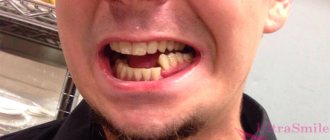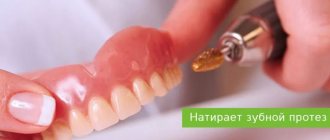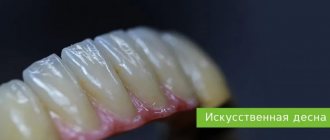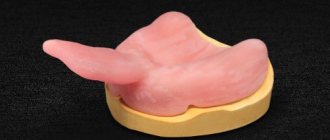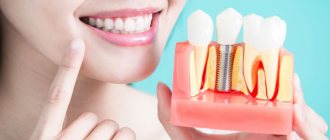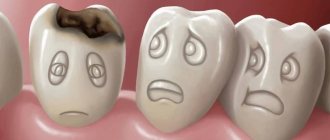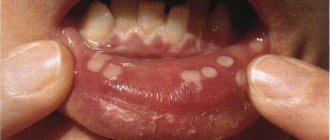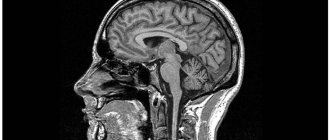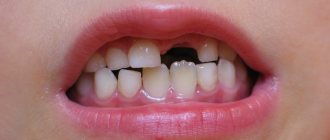Modern methods in dentistry, including the latest technologies in implantation, can solve almost any problem, including complete absence of teeth. However, installing a large number of implants entails large financial and time costs. It is not surprising that a system that requires only four implants and reduces surgical time can be considered the most optimal option for most patients. Dmitry Valerievich Levin, candidate of medical sciences, chief physician and implant surgeon of the Doctor Levin Center for Private Dentistry in Moscow, talks about the features of all-on-4 or “all on four” implantation.
Is all-on-4 implantation really not for everyone?
The fact that this solution is not suitable for everyone is only partly true: the all-on-4 protocol is used for resorption (resorption) or atrophy of mild or moderate bone tissue. That is, if the jawbone is severely atrophied, then four implants will actually not be enough.
There are many issues associated with this limitation: in particular, there are clinics that implement only the all-on-4 protocol and do not offer the patient alternatives, which means the solution is doomed to failure immediately. If there is little bone tissue or its quality is low (loose bone) or if there is acute inflammation of periodontal tissue, then the implant solution should be different. And the doctor must understand this if he wants his patient’s restored teeth to last as long as possible.
For example, adding NobelZygoma zygomatic implants to the upper jaw, or the all-on-6 protocol (the number of supports increases and with more pronounced atrophy the system will be more reliable). It is worth noting that sometimes six implants are not enough: in case of extreme resorption or inflammation, basal implantation is the best solution.
Indications for tooth restoration on four implants
That is, a personalized approach and thorough 3D diagnostics are important, which will allow you to assess the condition of tissues in volume from all sides and choose a truly suitable, individual solution.
Advice! Be sure to undergo 3D computer diagnostics before dental implantation. And visit several clinics - compare the proposed options, evaluate the doctors’ arguments in favor of one or another solution.
MYTH
The use of a clearly dictated All-on-4 protocol limits the possibilities - it is impossible to select places in the jaw bone tissue with the most suitable bone tissue in size and density.
IS IT TRUE
Those who say this have absolutely no understanding of what protocol is and certainly do not follow it. The All-on-4 protocol is a set of rules and methods combined into a sequence of actions for effective dental restoration in various clinical cases. And an integral part of its execution is 3D modeling of a specific clinical case to plan the placement of implants, taking into account the quality of the patient’s bone and the parameters of the formed bite. All this allows you to avoid mistakes and risks.
Indications and contraindications
Indications:
- The absence of more teeth in the presence of several elements that are no longer advisable to treat
- Complete edentia on one or both jaws
- Severe periodontitis (severe tooth mobility)
- Discomfort when wearing a removable denture
Contraindications:
- Severe bone atrophy
- Serious pathologies of the cardiovascular system
- AIDS, HIV
- Uncompensated diabetes mellitus
- Pregnancy and lactation
- Alcoholism and drug addiction
- Any disease in the acute stage
Important: indications and absence of contraindications are identified by the implantologist before the planning stage of the operation. The branches of the “Smile” clinic are equipped with high-precision diagnostic equipment. Our specialists quickly and accurately identify all the features of each clinical case and make the only right decision.
Algorithm for dental prosthetics using the “All on 4” technology
Stage 1 Diagnostic
Visual examination, hardware diagnostics (tomography and radiography), identification of contraindications
Stage 2 Preparatory
Sanitation of the oral cavity (dental and periodontal treatment, professional hygiene)
Stage 3 Implantation
Anesthesia of the operating area, removal of teeth (if necessary) and installation of four implants (or eight if prosthetics are intended for both jaws)
Stage 4 Osseointegration period
Implantation of implants (3 – 6 months), wearing a temporary prosthesis (installed either on the day of surgery or on the third day)
Stage 5 Dental prosthetics
Installation of a permanent prosthetic structure on established implants
A complete denture will not adhere well to the implants and some of them will be overloaded, is that true?
With the exception of the situations that we described above, four implants are quite enough to support a full-fledged denture of 10-12 crowns per row. Implants in the lateral zone are installed at an angle, thus using a larger area of the jaw bone.
In addition, the prosthesis has a metal frame (except for cases where the adaptive prosthesis is frameless and is placed on the day of the implantation surgery, that is, according to the “teeth in 1 day” protocol). The frame reliably connects and stabilizes the implants. There can be no rebound effect - due to the presence of a strong base inside the prosthesis, as well as planning the process of placing implants taking into account future prosthetics. In addition, we do not chew with only one extreme tooth - all side elements are used for this: the load is distributed evenly.
An example of creating a real frame for all-on-4 prosthetics and a model of two complete dentures with 12 crowns for each row
At the preparation stage, at least two doctors are involved in the process - an implant surgeon and an orthopedic dentist, who work closely together. And if the prosthesis is uncomfortable, does not normalize the bite, dangles, and so on, then this means that the surgeon and the orthopedist did not coordinate their actions, the prosthesis was not worked out before the start of treatment, and the implants were placed without further understanding of how the prosthesis would be attached to them .
Thanks to the NobelClinician software, which is used to plan all stages of all-on-4 implantation using the Nobel Biocare brand, the doctor analyzes the quality and quantity of bone in volume, selects the placement points of the implants, the dimensions of the structures, and their exact angle of inclination. Next, the entire “implant-prosthesis” structure is modeled, and multi-unit abutments with the appropriate angle on which the prosthesis will be attached are selected. Then it is calculated how the chewing load will be distributed: the bite parameters are taken, standard load parameters are entered into the program, and then the chewing process is simulated. Thus, the possibility of excessive load on the prosthesis and its breakage is completely eliminated.
We guarantee high results! We use only original implants and prosthetics for them. We do not skimp on your health and achieve lasting treatment results that will last for many years.
Free consultation
Are there any complications after the procedure?
Complications, of course, occur, for example, such as a fracture of the base of the prosthesis, but this can only happen with a temporary structure. With permanent restoration this is unlikely to happen. Also, at the early postoperative stage, inflammation of the mucous membrane may occur, but in the future, the formed mucous membrane remains healthy with proper care. The worst thing that can happen is perimlantitis - inflammation of the tissue near the implant caused by the appearance of pathogenic microbes between the implant and the bone tissue that holds it. That is, in essence, this is the destruction of the bone fragment that holds the implant. However, with careful care and good oral hygiene, in particular denture hygiene, this will not happen.
Is it possible to secure a prosthesis with only 10 crowns on 4 implants?
When using all-on-4 prosthetics, the length of the denture is 12 crowns (that is, 24 teeth on two jaws, normally there should be 28 living teeth). But it all depends on the situation and on the materials that will be used to make the prostheses. In the original Nobel Biocare protocol, prosthetics are performed up to the 6th tooth (adaptation period), which makes it possible to restore up to 90% of chewing function. With permanent prosthetics, chewing function is restored by 100%.
In rare cases, the doctor may actually decide to place a prosthesis consisting of only 10 crowns - but this is rare. And such a prosthesis is placed only on a temporary basis.
An example of an adaptive prosthesis consisting of 12 crowns on four Nobel implants. NobelZygoma zygomatic models were additionally used on the upper jaw
In general, this amount is more than enough for full chewing and even more so for creating a beautiful smile. If the patient insists on installing a prosthesis consisting of 14 crowns (up to 7 teeth), then several more supports will be required - for example, an all-on-6 protocol should be used. But it is important to remember that a solution with four implants is cheaper than with six, which is what accounts for its greater popularity. At the same time, there are no obvious functional differences in prostheses made of 12 or 14 crowns - you can eat fully with both, it’s just that when up to 6 teeth are restored, not 100%, but 90% of the chewing function is restored.
How much does it cost to install a dental implant in Moscow on a turnkey basis: full price of the service
You can get teeth placed on implants in Moscow at different prices. The promotional price starts from 140 thousand rubles for one jaw and includes all basic services. The minimum price is focused on the use of budget OSSTEM or Implantium implants with survival rates of 92-95%.
Maximum success is guaranteed by premium brands - Straumann and Nobel Biocare, but the price using implants from these manufacturers increases by 2-2.5 times.
Regular turnkey package:
- free consultation;
- surgical stage for installation of 4 implants;
- orthopedic stage - installation of a standard denture.
All other services must be negotiated additionally - as part of the offered package or at an additional cost.
Surgical templates do not help, but distort the picture when installing implants
Some doctors try to portray the use of surgical guides as a disadvantage. Arguing this is that such a landmark cannot be fixed, because bone atrophy manifests itself unevenly, which means there is a risk of installing an implant outside the desired area. If we are talking about standard guide templates, then this is indeed the case - but this was only the first step 10-15 years ago towards minimizing doctor errors.
Today, the development of digital technologies and robotic equipment makes it possible to create individual templates for each patient. Moreover, there are intraoral navigation systems for surgical procedures (GPS for the implantologist during surgery).
MYTH
When using a surgical template, there is a risk of installing an implant in an area with insufficient bone tissue. There is also a high probability of perforation of the bottom of the maxillary sinus in the upper jaw or damage to the mandibular nerve.
IS IT TRUE
Individual surgical templates are created precisely to protect the doctor and patient from damage to important organs and nerves, as well as to ensure accurate positioning in the bone according to a detailed plan on a 3D model of the jaw before surgery.
After careful planning of the “implant-prosthesis” design, several files are exported from NobelClinician, one of which is a task for a 3D printer to print an individual surgical template according to the data of the developed plan! The template takes into account the shape of the gingival margin, fits tightly to the mucosa, repeating the bends of the alveolar ridge. The templates are fixed on the jaw during surgery, which prevents their displacement. That is, if the process is carefully worked out in 3D, the likelihood of placing implants differently than intended is minimized. Only minor adjustments are possible in cases where the affected teeth are removed simultaneously with the installation of implants.
MYTH
Correct installation of implants can only be based on the results of 3D tomography (CT) of the jaw - this way the doctor can act more flexibly in the oral cavity, selecting areas with maximum volume and density of the jaw bone.
IS IT TRUE
Here it is worth asking a reasonable question - “how then does the doctor transfer the exact parameters of CT or 3D tomography into the oral cavity during surgery?” That's right - by eye and touch, without precise calculation. The conclusion is obvious - this is already the last century, because without accurate computer modeling of the implant treatment process there is a risk of making mistakes and losing the entire result.
So, as soon as you hear a doctor say that the use of surgical templates is a clear disadvantage, you can immediately and safely question his professionalism. Such a statement means that the doctor is distant and not even familiar with the original technology. I have never encountered the development of an individual template in practice, does not work in special software for treatment planning, and does not have special equipment for printing templates. You should be wary of his approach to installing implants - it can be dangerous: first of all, the loss of your health.
From the point of view of logic and translation of such a situation into ordinary life: which tailor would you prefer - the one who will sew according to an individual pattern, checking all the measurements several times, or the one who will simply estimate it by eye? Agree that there are few such talented geniuses, and we are dealing with health and your smile.
MYTH
When using a template, the proportion of trauma from surgery is greater, since it is necessary to peel off the gum flap to work with the bone.
IS IT TRUE
Surgical templates were created precisely to reduce the level of surgical intervention. They allow the implants to be positioned using the puncture method, without massive peeling of the flap, since the operation is planned in advance.
“The use of surgical templates simultaneously with 3D modeling of the implantation process makes the implantation result predictable. We do not work blindly, but have clear data on how to install implants, without injuring the sinuses or nerve endings, with the further possibility of performing high-quality prosthetics. This is a unified system and an integrated approach, and for the patient – the result that he initially expected.”
Bespalov Roman Dmitrievich, maxillofacial surgeon, implantologist, work experience of more than 26 years make an appointment
We learned from the best! Our doctors were trained by the developers of “all-on-four” implantation and visited the clinic of Dr. Paulo Malo, the founder of the method, in Portugal. We know exactly how to solve your problem with a guaranteed result using the original method!
Enroll now
What are the indications for All on Four dental implants?
One of the indicators can be the small volume of bone tissue in both the upper and lower jaws. It is especially problematic with the required volume of bone tissue for implantation in the chewing sections, since in the absence of teeth for quite a long time, the volume of bone tissue in these sections decreases, and this happens even when using removable dentures. In order to install the number of implants required for fixing fixed prostheses (from 6 to 10), a preliminary operation is required to restore the required bone volume. Only after this are implants installed, and after some time (from three to eight months) prosthetics are performed on them.
If the prosthesis is placed on the day of surgery, the gums will be injured
Adaptive prostheses for All-on-4 prosthetics are installed within 4-8 hours or on the 3rd day. In the first case, they are frameless, in the second - with a metal base for additional splinting of installed implants. Firstly, such prostheses are very light. Secondly, they are securely fixed on the implants, that is, they do not move under load, which means they do not touch the gums or injure them, and do not interfere with the full healing of the mucous membranes. Thirdly, their interior is very smooth and highly polished. That is, there can be no talk of any injury.
MYTH
Instant loading with a prosthesis impairs the healing of gums that have sutures; it is better to wait at least 3 days.
IS IT TRUE
Instant load, on the contrary, improves engraftment due to improved blood supply and high-quality lymphatic drainage. Metabolic processes are initiated optimally. In addition, self-absorbable barrier membranes are applied during the period of primary healing of soft tissues, which eliminates the additional risk of infection and inflammation.
In addition, the neck and upper body of Nobel Biocare implants are covered with an anodized gold Xeal™ surface, which ensures the integration of soft tissues with the implant, which subsequently creates a reliable barrier against the microbial environment entering the bone tissue and significantly reduces the level of gum and marginal bone loss.
Historical fact! Nobel Biocare are the first in the world to thoroughly develop the era of mucointegration, that is, to create implants with which not only bone, but also periodontal tissue is integrated.
The word “mucus” itself translated from Latin means “mucous”. Accordingly, in this context, mucointegration means the process of combining the implant with the mucous membrane. More precisely, the creation of maximum tight contact (adhesion), resulting in the formation of a barrier that protects the adjacent bone. And this is the key to a long service life of installed implants.
The level of keratinized (attached or upper part) gums with abutments with a Xeal surface is almost 2 times higher than with other systems
Naturally, during the first week, when tissue restoration occurs, the patient requires more gentle nutrition (more details can be found here), drug therapy, and high-quality hygienic care are important. But there will be no pain or acute discomfort. If the unpleasant sensations persist, there is a feeling of contact between the prosthesis and the gums, you can contact your doctor at any time to correct the structure.
Teeth in 1 day. Myth or reality?
Implantation with a single-stage load using the All-on-4 technique has been used for more than 20 years, but many people have distrust of the technique, as they consider it a “marketing ploy.” What is really real according to the All-on-4 method and what is not?
Is simultaneous loading harmful to implants?
It is necessary to distinguish between the following concepts:
- Single moment load.
- Early load.
- Delayed loading.
According to studies, after installing a titanium pin, its stability first decreases, and then begins to increase and reaches the required values after 3 months in the lower jaw and after 6 months in the upper jaw. Delayed loading is carried out exactly during these periods. This is the classic and most common method of prosthetics on implants.
The most critical period is from two weeks to two months after installation. It is at this time that the stability of the implant decreases and new bone tissue begins to form. Loading implants at this time poses the greatest risks. But when installing a prosthesis immediately after implantation or within a week after it, the implants are still stable in the bone, so the load will not harm them in any way.
It is worth noting that the simultaneous load of the entire jaw is more predictable than the simultaneous load of one implant. Because a fixed prosthesis connects titanium rods, eliminating dangerous lateral forces that could dislocate a single titanium screw with a temporary crown. But this does not mean that you should immediately use the immediately installed prosthesis as if you were using your own teeth. For the first two months, it is recommended to eat only soft and crushed food, then you can start eating regular food, but be sure to cut it into small pieces with a knife, and only from the fourth month (with implantation of the upper jaw) begin to chew your usual food.
Second question: how is a fixed prosthesis installed immediately after implantation?
In order for the prosthesis to be installed immediately after the installation of implants, a preliminary visit to the dentist is necessary. Before installing artificial roots, impressions are taken of both jaws. Based on the casts, models are made (plaster copies of teeth and jaws), on which the future prosthesis is modeled. Holes are created in it where the implants will approximately be installed. The implantologist can also use such a prosthesis as a template for placing implants. After implantation, temporary abutments or multi-unit abutments are installed, depending on what type of prosthesis fixation will be used (cement or screw). The prosthesis is installed on the abutments, and relining is carried out in the area of the holes. Thus, the prosthesis is fixed to the implants.
The advantages of this method are that the prosthesis is installed immediately after implantation. But if the operation is planned with the simultaneous removal of teeth, then this will affect the accuracy of the prosthesis, because The impressions for its production will be taken while the teeth are not yet removed. This will lead to the fact that the prosthesis in these places will be made approximately, and a lot of relining will be required. Also, the position of implants immediately after tooth extraction cannot be predicted with the same accuracy as in an edentulous jaw.
An alternative option is to take impressions immediately after implantation, make a prosthesis and fix it in 1-7 days. This variation in time is not related to the time of manufacture of the prosthesis, because this can be done quite quickly, and with the appearance of gum swelling, which disappears just on the 7th day.
The advantages of this method are that the prosthesis is made more accurately, because The position of the implants and the gingival contour are already clear. Fixation of the prosthesis on the 7th day immediately after removal of the sutures. The disadvantage of this approach is that you will have to go without teeth for 7 days.
To install a fixed prosthesis immediately after implantation, it is made in advance with holes for abutments. After implantation, the prosthesis is relined and fixed to the implants.
Can the screw fastening become loose and the prosthesis fly off...?
Screw fastening is currently considered the most advanced when carrying out both single restorations and when restoring a full row of teeth - this is the most reliable solution. The dentures are attached using small screws - they are inserted into the abutment and implant through the chewing surface of the crowns. The holes are filled from above with a liquid light-curing polymer. This fastening allows, if necessary, to remove the prosthesis, reline it or clean it without damaging the implants.
MYTH
All-on-4 does not have the ability to combine the method of fastening the prosthesis with screws and with cement at the same time.
IS IT TRUE
Yes, indeed it is. But this is an advantage! No one will combine two completely different types of fastening in one prosthesis, because then there is no point in more expensive screw fixation. The prosthesis is placed on the entire jaw and is a complete structure, not assembled into segments. If some part of it is fixed to cement, then it will be impossible to remove it without cutting, even if there is a screw fixation in another area. This means that after such removal, the entire structure of the prosthesis will need to be changed.
Of course, screw fastening has certain disadvantages. In particular, loss of screw fixation may occur. But this phenomenon is extremely rare in good implant systems and most often occurs due to refusal of timely correction or change of the adaptive design to a permanent one, as well as abuse of hard foods. The situation is easily corrected - the screws are tightened/changed.
If you follow all the recommendations of your doctor, undergo timely examinations as part of free service, you will not encounter problems with the integrity of the prosthesis.
Possible complications
It must be taken into account that after implantation, complications may develop, the most likely of which are:
- implant rejection – occurs due to biological incompatibility of living tissues with the metal of the structure;
- peri-implantitis is a purulent inflammatory process provoked by infection;
- pain – headaches, as well as localized in the area of implants, temporomandibular joint;
- swelling of the soft tissues, minor bleeding is the norm in the early postoperative period, but if these phenomena are protracted, they are a sign of pathology;
- an unpleasant odor is usually a consequence of improper care of an artificial jaw with 4 implants.
To exclude post-implantation complications, three conditions must be met. First, choose high-quality implants with prostheses from reliable well-known manufacturers. Secondly, contact dental clinics where highly qualified implant surgeons work, like in Yulisty. Thirdly, take proper care of the orthopedic structure - clean it regularly, use an irrigator, and come for professional cleaning on time.
When urgent help is needed
Normally, pain and swelling of the gums disappear a few days after the procedure. Headaches or discomfort in the temporomandibular joint may occur due to atrophy of the masticatory muscles after a long period of absence of teeth. As a rule, they also pass quickly after restoration of muscle function. However, in some cases, urgent medical intervention is necessary:
- prolonged bleeding - can be caused by damage to blood vessels during surgery;
- increasing swelling and pain, increased temperature - signs of an inflammatory process;
- discharge of fluid from the nose is a consequence of damage during implantation of the maxillary sinuses;
- numbness of the jaw is the result of cutting or pinching of the conductive nerves during the installation of implants.
General overview
The list of elements included in the system includes:
- Implants made of biologically compatible material;
- A specially shaped beam made of metal;
- A retainer (abutment) connecting the prosthesis and the base.
The main ideas behind the development of the beam-type system were effective load distribution and fastening of dentures. The metal beam equalizes the mechanical pressure that occurs during chewing food, preventing imbalance of artificial crowns and maintaining a tight connection between the base and the conditionally removable structure. For fixation, special locks are used that are invisible from the outside.
What is a beam prosthesis?
The peculiarity of the beam prosthesis is the method of its fixation. The fastening element consists of two parts - a beam and a semicircular metal pipe. The beam connects the implants, the pipe is inserted inside the prosthesis. When fixed, it is put on the beam and latched with a special lock.
Bar dentures are conditionally removable; for daily hygiene it does not need to be removed from the oral cavity. The structure should be removed when visiting the dentist for thorough cleaning or replacement.
Care and hygiene
A correctly manufactured and installed removable denture on a beam on implants fully restores the functionality and aesthetics of the dental system. But just like your teeth, any prosthetic structure needs daily hygienic care.
To clean the lateral spaces between the implants and under the bar, it is recommended to use thick dental floss or an irrigator for atraumatic cleansing using a pressurized water jet.
To keep artificial teeth smooth, it is best to use a non-abrasive toothpaste and a soft toothbrush.
The inside of the prosthesis also needs to be looked after - it is recommended to remove and clean the prosthesis in a clinical setting once a month.

